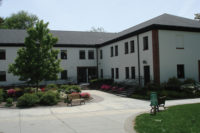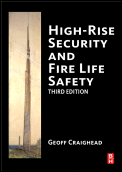Cultural institutions, such as museums and libraries, have a unique set of characteristics that make fire and life safety requirements different from those of other buildings. A life safety system must simultaneously safeguard precious objects and protect patrons — and do so with minimal distractions or disruptions.
According to the National Fire Protection Association (NFPA), an average of 1,200 fires occurred in U.S. libraries, museums, courthouses and other public property between 2003 and 2006. Of the 22 industrial nations examined by the World Fire Statistics Centre, the U.S. fire death rate was higher than all but two: Finland and Hungary. One possible reason for this fact is that the United States emphasizes the use of advanced fire suppression technology and fire service delivery mechanisms, while other nations emphasize fire prevention.
What is the ideal scenario? Fire and life safety strategies need to be minimally intrusive and maximally effective in spaces such as museums, requiring a more innovative approach. Good fire safety also must be inherent in museum design to protect the museum’s treasures, as well as its visitors
and staff.
To be most effective, it is wise to think of fire and life safety tactics in terms of being all-encompassing and more redundant, similar to what is required in a data center. This likely involves a three-tier approach: prevention, detection and suppression.
Fire Prevention
Although some aspects of fire and life safety are beyond one’s control — such as the detection and protection methods implemented in adjoining or adjacent properties — a good fire prevention plan should consider all controllable aspects. This includes knowing the potential trigger points for emergencies, as well as training employees on best practices to avoid fire occurrences.
If a fire occurs, it is critical to prevent the spread by limiting the amount of available fuel, confining the fire in a space with limited oxygen, and activating an automatic fire suppression system. Barriers also can limit the spread of fire, smoke, and other combustion products.
An enclosed stairway is an example of a structural feature that serves as both a fire barrier and a smoke barrier. Open stairways act as chimneys in a fire by drawing flame, smoke, and products of combustion from one floor to another. Secured doors on each floor can prevent the spread of fire and smoke, but it only takes a single open door to compromise the protection.
Fire Detection
Spot-type photoelectric or ionization smoke detectors are most common in cultural facilities. Generally, photoelectric detectors react more quickly to smoldering fires that produce visible smoke, whereas ionization detectors react more quickly to invisible products of combustion and flaming fires. Detector selection may vary from room to room, depending upon the construction, furnishings and operations. A single spot-type smoke detector can typically protect a room of up to 900 square feet.
However, historic or cultural buildings often give special attention to the aesthetics of their spaces, and spot detectors can be a visual hindrance. Aspirating smoke detection is an alternative, which is capable of providing very early warning smoke detection. Aspirating systems such as the one shown above, model 8100 in the FAAST Fire Alarm Aspiration Sensing Technology® series from System Sensor, are active systems: they use air sampling to continually draw in and examine the air from one or more rooms. The system’s pipe network can remain hidden in spaces such as ceiling voids while sampling air from the protected space through discreet holes.
Fire Suppression
There are several kinds of automatic suppression systems, including conventional sprinklers, water mist sprinklers, dry pipe sprinklers, and extinguishing gases. System selection is dependent upon a variety of factors, such as the life safety requirements, building significance, content value, aesthetics, historic features, codes, and costs.
A fire protection system is effective only if detection offers enough warning for suppression to do its job. Whether suppression entails an automatic sprinkler system or other equipment to extinguish a fire, it’s important to use detection that triggers an appropriate suppression response to minimize damage, either from fire or the suppression system itself.
Suppression also can be as basic as an in-person inspection of smoke in the incipient stage. An added benefit of many aspirating smoke detection systems is that they can provide appropriate personnel with very early warning of fire to investigate issues before actual combustion and damage occurs. Many of these systems also provide multiple levels of alert that can be synchronized with a staged response plan. This level of sensitivity and customization can be invaluable in spaces that house valuable items.
Holistic Approach
Consider an art museum, which has the challenge of protecting priceless, irreplaceable historical works of art in addition to safeguarding patrons. Because fire must be rapidly detected and extinguished to avoid unnecessary damage to the collection, standard ionization and photoelectric smoke detectors may not be an option. While these detectors may provide ample warning in other sections of the museum, such as office areas and mechanical rooms, they typically do not provide the incipient fire detection necessary to protect art treasures from smoke damage. Exhibit and curation areas need to have fires detected at the earliest stages of combustion, even before smoke is visible to the human eye.
These areas are where an air sampling system is the best fit. Because air sampling with programmable detection/warning levels is many times more sensitive than standard fire alarm smoke detectors, it gives first responders an opportunity to evaluate the situation and take appropriate action, which may negate proceeding to the next level of protection.
Therefore, all areas do not necessarily require the same level and type of protection. A museum’s preservation center and mechanical room have different fire protection and containment requirements that need to be addressed. Consider the February 2011 fire incident in a heating and air conditioning equipment outbuilding of the Smithsonian Museum of Natural History as an example: the fire sent a large plume of smoke over the National Mall in Washington D.C. The adjacent museum exhibits were spared from damage because of the extra measures taken to protect against this possibility.
Yet, protection is not limited to the museum exhibits, public spaces, and outbuildings. Consideration also is needed where items may be stored or sent out for exhibit. For example, the Road to Tara Museum in Jonesboro, Ga. — which displays a collection of memorabilia and other items related to the classic motion picture “Gone with the Wind” — stored a portion of its collection in a climate-controlled self-storage facility. A February 2012 fire at the storage facility resulted in extensive damage to the collection. This prompts the design direction to consider the ancillary spaces and locations that follow precious artifacts.
When approaching fire and life safety for cultural facilities, a holistic approach improves damage prevention and mitigation and enhances the recovery capability. This can maximize return on investment in the long run.









